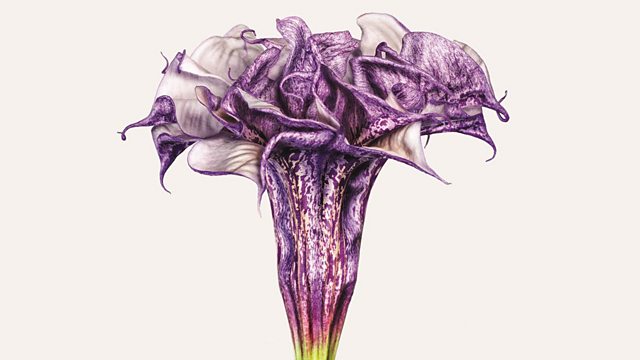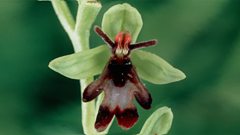Plant and flower shapes
Are we any closer to understanding how and why did the amazing diversity of living shapes evolve?
The amazing shapes of plants and flowers, one of nature’s biggest mysteries: why are they so varied and beautiful? Joining Bridget Kendall are Enrico Coen, who has been making exciting discoveries about how small buds transform themselves into remarkably complex leaves and flowers; Andrew Zuckerman, who explains his quest to capture the essence of a flower’s shape in a single photograph; and Lars Chittka, who invites us to look at flowers through the eyes of bees and other pollinating insects. Photo by Andrew Zuckerman (Jimson Weed, Thorn Apple)
Last on
More episodes
Previous
Clip
Enrico Coen

Self-making Pots by Enrico Coen and Tilly Eldridge

Andrew Zuckerman

Noted New York photographer and filmmaker, Andrew Zuckerman makes intimate portraits of animals, people and flowers set against his signature white background. He says that this distinctive approach allows him to remove subjects from their context and enables a larger conversation between them.
Andrew Zuckerman: Jimson Weed, Thorn Apple (Datura)

Andrew Zuckerman: Jade Vine

Photo Credit: Andrew Zuckerman
Andrew Zuckerman: Darwin's Star Orchid

Photo Credit: Andrew Zuckerman
Lars Chittka

Professor Lars Chittka is the founder of the Research Centre for Psychology at Queen Mary, University of London. One of the things that he studies at his lab is the way plants interact with other creatures, especially pollinators such as bees, which turns out to be quite a complex relationship of mutual evolutionary influences.
60 Second Idea
Biologist Lars Chittka suggests that we use genetic engineering to breed hybrid and fantasy creatures that human imagination has spawned, from Greek mythology through fairy tales, e.g. mermaids, minotaurs, centaurs, gnomes. On Earth, there are no more new continents with strange life forms to discover and we are a long way from exploring alien life, so in the meantime, to combat boredom, we should invent our own life forms and shapes.
Poem by listener Catherine Diamond inspired by the programme
The Language of Flowers
by Catherine DiamondA rose maybe a rose maybe a rose
to Juliet and her lover’s nose
but not to the flower itself
that doesn’t know a phylum from a family
but may hold secrets of different kind
known only to the members of its tribe.
��
For all we know, one red-petaled wonder
may choose to love another
overwhelmed by mysterious passion
that defies reason and practical promiscuity.
��
Perhaps it’s not just the instinct to breed
or selection for survival alone
that guides the union of two plants;
perhaps not all is left to chance
and even in the vegetal world.
flowers have their own language of romance.In Next Week's Programme
New paths for growing businesses in our changing world, with Canadian investor Sherry Coutu, Ugandan coffee entrepreneur Andrew Rugasira and American anthropologist Catherine Dolan.
Broadcasts
- Sat 12 Jan 2013 13:05GMT����ý World Service Online
- Sat 12 Jan 2013 23:05GMT����ý World Service Online
- Sun 13 Jan 2013 02:05GMT����ý World Service Online
What is the role of libraries in the digital age?
Podcast
-
![]()
The Forum
The programme that explains the present by exploring the past




